Our team is highly trained and experienced in servicing and producing all types of steel supplies. Need help or have a question?
sales@abrasionresistantpipe.com
Tel.: +8621-3378-0199
Our team is highly trained and experienced in servicing and producing all types of steel supplies. Need help or have a question?
sales@abrasionresistantpipe.com
Tel.: +8621-3378-0199

JIS G3455 STS 480 seamless carbon steel pipes are used for high pressure service at an approximate maximum temperature of 350℃.
JIS G3455 STS 480 is a grade of carbon steel pipes specified by the Japanese Industrial Standard (JIS) under the JIS G3455 standard. The JIS G3455 standard specifies carbon steel pipes for high pressure service at an approximate maximum temperature of 350°C.
STS 480 is a higher strength grade compared to STS 370 and STS 410, with a minimum tensile strength of 480 MPa and a minimum yield strength of 315 MPa. These pipes can be produced using either a seamless or welded process, depending on the specific requirements of the application.
These carbon steel pipes are commonly used in industrial applications where high-pressure and high-temperature conditions are present, such as steam boilers, pipelines, and high-pressure equipment. They provide excellent mechanical properties to withstand such conditions, making them suitable for use in harsh environments.
JIS G3455 STS 480 Carbon Steel Pipes are a grade of carbon steel pipes used for high-pressure service at high temperatures. With a minimum tensile strength of 480 MPa and a minimum yield strength of 315 MPa, they are suitable for a variety of industrial applications where harsh conditions exist.
These carbon steel pipes are designed to withstand high-pressure and high-temperature conditions, making them suitable for use in applications such as steam boilers, pipelines, and high-pressure equipment. The pipes are manufactured through a seamless process or a welded process, depending on the requirements of the application.
The mechanical properties of JIS G3455 carbon steel pipes vary depending on the grade. For example, STS 370 has a minimum tensile strength of 370 MPa and a minimum yield strength of 215 MPa, while STS 510 has a minimum tensile strength of 510 MPa and a minimum yield strength of 335 MPa.
| Letter symbol of grade | Hot-finished seamless steel pipe | Cold-finished seamless steel pipe |
| STS 480 | Low temperature annealed of normalized | |
| Grade | Chemical Composition % | ||||
| C | Si | Mn | P | S | |
| STS 480 | 0.33 max. | 0.10~0.35 | 0.30~1.50 | 0.035 max. | 0.035 max. |
| Letter symbol of grade | Mechanical Properties | |||||
| Tensile strength | Yield strength | Elongation % | ||||
| kgf/m㎡ {N/ m㎡} | kgf/m㎡ {N/ m㎡} | No.11 and No.12 test pieces | No. 5 test pieces | No. 4 test piece | ||
| Longitudinal | Transverse | Longitudinal | Transverse | |||
| STS 480 | 49{481} min. | 28{275} min. | 25 min. | 20 min. | 17 min. | 22 min. |
(1)The pipe are practically straight, and its both ends shall be at a right angle to its axis.
(2) The inside and outside surfaces of the pipe shall be well-finished and free form defects that are detrimental to practical use.
(1)Chemical analysis
(2)Tensile Test
(3)Flattening Test
(4) Bending Test
(5) Hydrostatic Test or Nondestructive Examination
| Division | Tolerances on outside diameter | Tolerances on wall thickness | Tolerances on wall thickness deviation |
| Hot-finished seamless steel pipe | 50mm Under 【0.5mm | ≤4mm Under +0.6mm -0.5mm ≤4mm or over +15% -12.5% |
Within 20% of wall thickness |
| 50mm or over 200mm to and excl. 【1.6mm |
|||
| 200mm of over 【0.8% | |||
| For the pipe 350mm of over, the tolerances on outside diameter may be determined by the measurement of the length of circumference. shall be 【0.5%. |
|||
| Cold-finished seamless steel pipe | 40mm Under【0.3mm | ≤2mm Under 【0.2mm |
– |
| 40mm of over 【0.8% | ≤2mm or over 【10% |
||
| For the pipe 350mm or over, the tolerances on outside diameter may be determined by the measurement of the length of circumference, In this case, the tolerances shall be 【0.5%. |
Japanese Industrial Standards (JIS) developed by the organization apply to a wide variety of industrial services and technologies such as automobiles, metallurgy, ships and medical equipment
The method for making cold-drawn seamless pipes involves taking a round “billet” or bar of steel and boring it in the center, turning it, cutting it, heating it to make it more pliable, then “drawing” it (extruding or pulling it) to make it a longer and thinner tube.
Japanese Industrial Standards specifies the standards used for industrial activities in Japan. The standardization process is coordinated by Japanese Industrial Standards Committee and published through Japanese Standards Association.
The Industrial Standardization Law was revised in 2004 and the JIS mark product certification system was changed. Standards are named like “JIS X 0208:1997″, where X denotes area division, followed by four digits (or five digits for some of the standards corresponding ISO standards) and the revision release year.
MTC IN EN 10204.3
EN 10204:2004 is for metallic products-and this norm tell us things about Types of inspection documents. There are no material standards.
Mostly material is defined with its chemical composition and mechanical properties in a public standars like ISO, EN, JIS, ASTM etc.
What is JIS?
Japanese Industrial Standards (JIS) specifies the standards used for industrial activities in Japan. The standardization process is coordinated by Japanese Industrial Standards Committee and published through Japanese Standards Association.
| APPLICATION | TOLERANCE ON OUTSIDE DIAMETER (MM) | |
|---|---|---|
| JIS G3441 JIS G3444 JIS G3445 | 50 | ±0.5 |
| >50 | ±1% | |
| JIS G3441 JIS G3444 JIS G3445 | <50 | ±0.25 |
| >50 | ±0.5% | |
| JIS G3441 JIS G3445 | <25 | ±0.12 |
| >25-40 | ±0.15 | |
| >40-50 | ±0.18 | |
| >5:.60 | ±0.20 | |
| >60-70 | ±0.23 | |
| >70-80 | ±0.25 | |
| >80-90 | ±0.30 | |
| >90-100 | ±0.40 | |
| >100 | ±0.5% | |
| JIS G3441 | <13 | ±0.25 |
| >13-25 | ±0.40 | |
| >25-40 | ±0.60 | |
| >40-65 | ±0.80 | |
| >65-90 | ±1.00 | |
| >90-140 | ±1.20 | |
| >140 | By agreement | |
| APPLICATION | TOLERANCE ON WALL THICKNESS (MM) | |
|---|---|---|
| JIS G3441 JIS G3444 JIS G3445 | <=4 | -0.5,+0.6 |
| >4 | -12.5%, +15% | |
| JIS G3441 JIS G3444 JIS G3445 | <=3 | ±0 .3 |
| >3 | ±10% | |
| JIS G3441 JIS G3445 | <=2 | ±0.15 |
| >2 | ±8% | |
| APPLICATION | TOLERANCE ON OUTSIDE DIAMETER | TOLERANCE ON WALL THICKNESS | ||
|---|---|---|---|---|
| <40A | ±0.5mm | <=4mm | +0.6mm | |
| >50A, <125A | ±1% | -0.005 | ||
| Hot rolled seamless pipes | 150A | ±1.6mm | >4mm | +15% -12.5% |
| >200A | ±0.8% | |||
| More than 350mm,the tolerance is ±0.5% | ||||
| Cold drawn seamless pipes and electric resistant welded pipes | <25A | ±0.3mm | <=3mm | ±0.3mm |
| >32A | ±0.8% | >3mm | ±10% | |
| But more than 350mm, the tolerance is ±0.5% | ||||
| APPLICATION | TOLERANCE ON OUTSIDE DIAMETER | TOLERANCE ON WALL THICKNESS | ||
|---|---|---|---|---|
| Hot Rolled Seamless Pipes | <=50mm | ±0.5mm | <=4mm | ±0.5mm |
| >50-160mm | ±1% | |||
| >160-200mm | ±1.6mm | >4mm | ±12.5% | |
| >200mm | ±0.8% | |||
| More that 350mm, the tolerance is ±0.5% | ||||
| Cold Drawn Seamless Pipes and Electric Resistant Welded Pipes | <=40mm | ±0.3mm | <=2mm | ±0.2mm |
| >40mm | ±0.8% | >2mm | ±10% | |
| More than 350 mm the tolerance is ±0.5% | ||||
However, the Japanese government did have standards and specification documents for procurement purposes for certain articles, such as munitions. These were summarized to form an official standard old JES in 1921. During World War II, simplified standards were established to increase matériel output. The Industrial Standardization Law was enacted in 1949, which forms the legal foundations for the present Japanese Industrial Standards.

JIS seamless pipe according to alloy, stainless steel or carbon. It tests steel’s properties, hardness, resistance to corrosion, pitting, heat treating processes and others. The results are listed in a main JIS steel grade for steel pipe as below.
Seamless Steel Oil Well, Casing, Tubing and Drill Pipe
Steel grade: STO-G, STO-H, STO-J, STO-N, STO-C, STO-D, STO-E
Application: Seamless Steel Oil Well, Casing, Tubing and Drill Pipe
Steel grade:SCr 420TK, SCM415TK, SCM418TK, SCM420TK, SCM430TK, SCM435TK, SCM440TK
Application:Alloy Steel Tubes for General Structural Purpose
Steel grade: STK 30, STK 41, STK 50, STK 51, STK 55
Application: Carbon Steel Tubes for General Structural Purpose
Dimension Range: 21.7-1016.0 mm
Application: Carbon Steel Tubes for Machine Structural Purposes
Steel grade: STS 38, STS 42, STS 49
Application: Carbon Steel Pipes for High Pressure Service
Dimension Range: 10.5-660.4 mm
Steel grade: STPT 38, STPT 42, STPT 49
Application: Carbon Steel Pipes for High Temperature Service
Dimension Range:10.5-660.4 mm
Steel grade:STPL 39, STPL 46, STPL 70
Application: Steel Pipes for Low Temperature Service
Dimension Range:10.5-660.4 mm
Steel grade: STBL 39, STBL46, STBL 70
Application: Steel Heat Exchanger Tubes for Low Temperature Service
Dimension Range: 15.9-139.8 mm
Steel grade: STM-055, STM-C65, STM-R60, STM-1170, STM-1180, STM-R85
Application: Seamless Steel Tubes for Drilling
Dimension Range: Casing: 43-142mm / Hollow Pipes: 34-180mm / Drilling:33.5-50mm
Steel grade: STF 42, STFAl2, STFA22, STFA23, 5TFA24, STFA23, STFA26
Application:Steel Tubes for Fired Heater
Dimension Range:60.5-267.4mm
JIS G 3101 SS400 is one of the most commonly used hot rolled general structural steel.
SS400 is a Japanese brand of ordinary steel products,
The production of our seamless pipes is tightly regulated and all of the pipes we stock have been fully tested to international standards to ensure we only supply the highest quality products.
| Product name | Executive standard | Dimension (mm) | Steel code/ Steel grade |
|---|---|---|---|
| Black and Hot-dipped Zinc-coated Steel Pipes Seamless | ASTM A53 | 0.3-1200 x 1.0-150 | GR.A, GR.B, GR.C |
| Seamless Carbon Steel for High Temperature Service | ASTM A106 | 10.3-1200 x 1.0-150 | GR.B, GR.C |
| Seamless Cold-drawn Low-Carbon Steel Heat-Exchanger and Condenser Tubes | ASTM A179 | 10.3-426 x 1.0-36 | Low Carbon Steel |
| Seamless Carbon Steel Boiler Tubes for High Pressure | ASTM A192 | 10.3-426 x 1.0-36 | Low Carbon Steel |
| Seamless Cold-drawn Intermediate Alloy Steel Heat-exchanger and Condenser Tubes | ASTM A199 | 10.3-426 x 1.0-36 | T5, T22 |
| Seamless Medium-carbon Steel Boiler and Superheater Tubes | ASTM A210 | 10.3-426 x 1.0-36 | A1, C |
| Seamless Ferritic and Austenitic Alloy Steel Boiler, Superheater and Heat-exchanger Tubes | ASTM A213 | 10.3-426 x 1.0-36 | T5, T5b, T9 , T11, T22 ,T91 |
| Seamless Carbon and Alloy Steel for Mechanical Tubing | ASTM A333 | 1/4"-42" x SCH20-XXS | Grade1 Gr. 3,Gr..6, Gr.8 , Gr. 9 |
| Seamless Cold-drawn Carbon Steel Feedwater Heater Tubes | ASTM A556 | 10.3-426 x 1.0-36 | A2, B2 |
| Round and shaped steel cold formed welded and seamless carbon steel structural pipe. | ASTM A500 | OD :10.3-820 x 0.8- 75 | Grade A, B, C, D |
| Carbon and alloy steel mechanical tubing, either hot-finished or cold-finished | ASTM A519 | 10.3-426 x 1.0-36 | 1020, 1025, 4130, 4140 |
| For seamless ferritic alloy-steel pipe for high-temperature service | ASTM A335 | 1/4"-42" x SCH20-XXS | A/SA 335 P1, P2, P11, P12, P15, P22, P91, P92, P122 |
Cold Drawn Seamless Mechanical Tubing (CDS) is a cold drawn 1018/1026 steel tube which offers uniform tolerances, enhanced machinability and increased strength and tolerances compared to hot-rolled products. 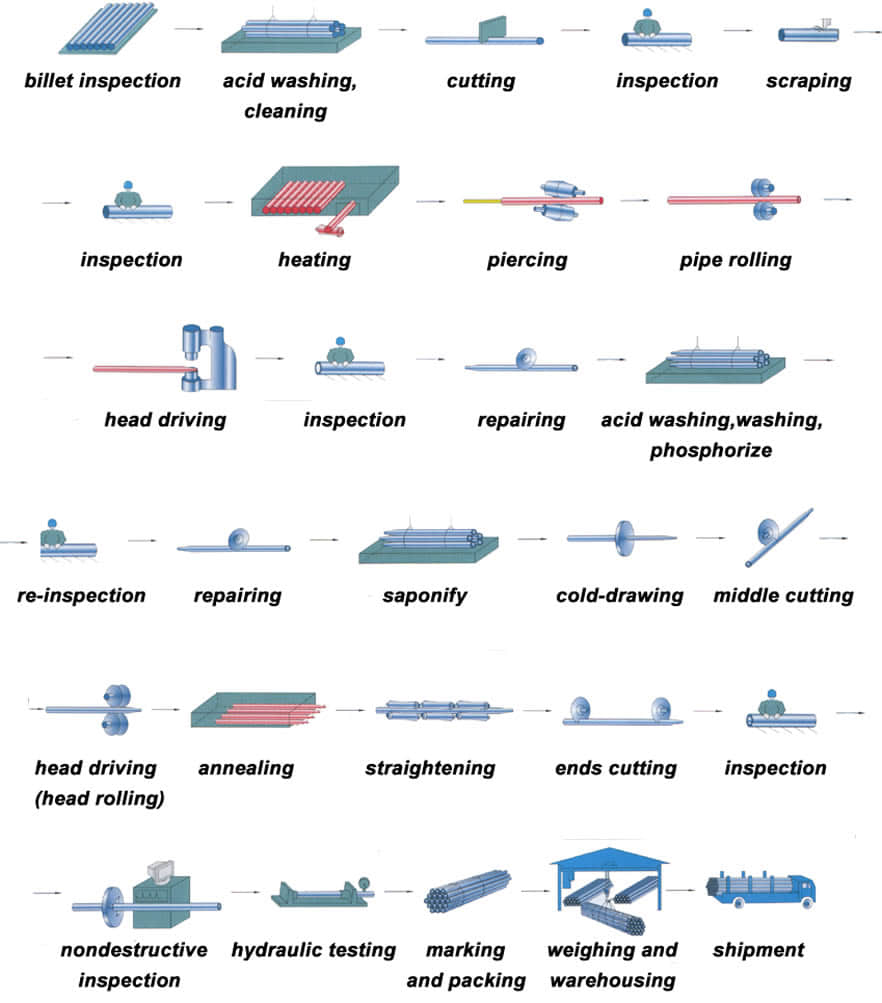 Cold drawn steel tube is with hot-rolled steel coil as raw material, and tandem cold rolling pickled to remove oxide scale, its finished rolling hard roll, rolling hard volumes due to the continuous cold deformation caused by cold hardening strength, hardness increased indicators declined tough plastic, stamping performance will deteriorate, which can only be used for simple deformation of the parts. Rolling hard roll can be used as the raw material of the hot-dip galvanizing plant, hot dip galvanizing line set annealing line. Rolling hard roll weight is generally 6 to 13.5 tons, the coil diameter of 610mm.
Cold drawn steel tube is with hot-rolled steel coil as raw material, and tandem cold rolling pickled to remove oxide scale, its finished rolling hard roll, rolling hard volumes due to the continuous cold deformation caused by cold hardening strength, hardness increased indicators declined tough plastic, stamping performance will deteriorate, which can only be used for simple deformation of the parts. Rolling hard roll can be used as the raw material of the hot-dip galvanizing plant, hot dip galvanizing line set annealing line. Rolling hard roll weight is generally 6 to 13.5 tons, the coil diameter of 610mm.
Hot-rolled seamless steel pipe production base deformation process can be summarized as three stages: perforation, extension and finishing. 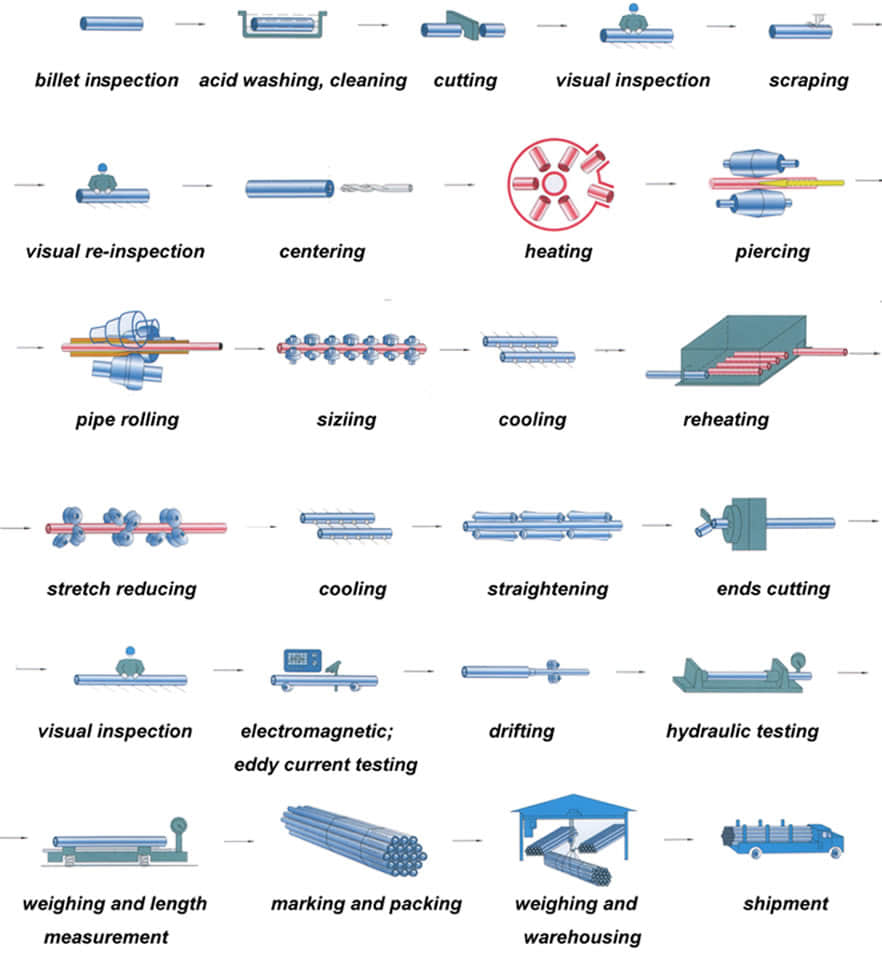 The main purpose of the perforation process is to become a solid round billet piercing hollow shell. Capillary in the specifications, accuracy and surface quality can not meet the requirements of the finished product, further improvements are needed to deform the metal through. The main purpose of the stretching machine is further reduced sectional view (main compression wall) for a larger axial extension, so that the capillary improved dimensional accuracy, surface quality and organizational performance. After stretching machine rolled steel pipe shortage collectively need further molding mill in order to achieve the requirements of the finished pipe. Rolled steel due to pass in the method widely used in the production of seamless steel tubes. So far, due to the method pass rolling steel can be divided into two categories: core pension without rolling rolling (hollow body rolling), and with the mandrel. Sizing machines, reducing mill and stretch reducing mill belonging to the hole without mandrel type continuous rolling mills are generally coffin. Its main purpose is to reduce the diameter of the deformation process or sizing get finished steel, the wall thickness of process control, can make thinning, thickening or nearly unchanged. All the traditional hole-type rolling machine with mandrel belong to extend machine. The main purpose is to reduce the deformation process perforated capillary wall thickness and outer diameter roll passes in the deformation zone and the mandrel posed, for a larger axial extension. At the same time a certain improvement in the organization, performance, accuracy, surface quality.
The main purpose of the perforation process is to become a solid round billet piercing hollow shell. Capillary in the specifications, accuracy and surface quality can not meet the requirements of the finished product, further improvements are needed to deform the metal through. The main purpose of the stretching machine is further reduced sectional view (main compression wall) for a larger axial extension, so that the capillary improved dimensional accuracy, surface quality and organizational performance. After stretching machine rolled steel pipe shortage collectively need further molding mill in order to achieve the requirements of the finished pipe. Rolled steel due to pass in the method widely used in the production of seamless steel tubes. So far, due to the method pass rolling steel can be divided into two categories: core pension without rolling rolling (hollow body rolling), and with the mandrel. Sizing machines, reducing mill and stretch reducing mill belonging to the hole without mandrel type continuous rolling mills are generally coffin. Its main purpose is to reduce the diameter of the deformation process or sizing get finished steel, the wall thickness of process control, can make thinning, thickening or nearly unchanged. All the traditional hole-type rolling machine with mandrel belong to extend machine. The main purpose is to reduce the deformation process perforated capillary wall thickness and outer diameter roll passes in the deformation zone and the mandrel posed, for a larger axial extension. At the same time a certain improvement in the organization, performance, accuracy, surface quality.
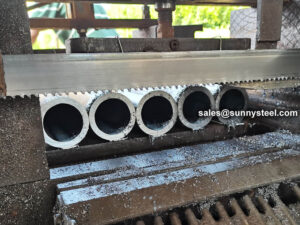
Before cutting pipe and tubing No matter the material, measure the diameter of the pipe or tube to be cut to ensure that you use the right-size tube cutter for the job. When determining how to make a straight cut, use a tape measure and a pencil or other writing instrument to mark on the surface where you want to cut. If possible, mark around the circumference of a pipe, especially when cutting with a handsaw. Ensure that a cut is as straight as possible by securing the pipe with a vise, clamp, miter box or even duct tape to keep the length from shifting out of place while cutting. After cutting pipe and tubing
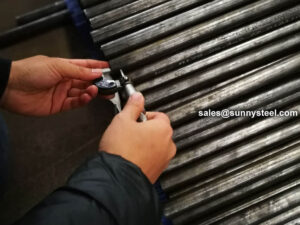
Geometrical inspection of steel pipes The outer diameter, wall thickness, bending and length of the steel pipe can be inspected on the inspection table with an outer caliper, a micrometer and a bending ruler, and a length tape measure.
Take seamless steel pipe as an example, there are some tolerances that affect quality. Noting this, and you will get a better pipe.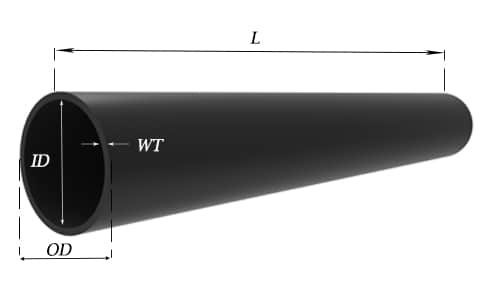
Weight tolerance
For pipe NPS 12 (DN300, 323.8mm) and under, the weight shall vary within -3.5% / +10%.
For pipe over NPS 12 (DN300, 323.8mm), the weight shall vary within -5% / +10%.
Pipe of NPS 4 (DN100, 114.3mm) and smaller may be weighed in convenient lots; pipe in sizes larger than NPS 4 shall be weighed separately.
Quantity tolerance
Normally mills take -10% to +10% tolerance, but TPMCSTEEL keeps ±3% variation.
Length tolerance
For Seamless pipe& tube, if definite cut lengths are ordered, the length shall vary within -0mm / +6mm.
| Pipe types | Pipe Szie(mm) | Tolerances | |
|---|---|---|---|
| Hot rolled | OD | <50 | ±0.50mm |
| ≥50 | ±1% | ||
| WT | <4 | ±12.5% | |
| ≥4-20 | +15%, -12.5% | ||
| >20 | ±12.5% | ||
| Cold drawn | OD | 6-10 | ±0.20mm |
| 10-30 | ±0.40mm | ||
| 30-50 | ±0.45 | ||
| >50 | ±1% | ||
| WT | <1 | ±0.15mm | |
| >1-3 | + 15%, – 10% | ||
| >3 | + 12.5%, – 10% | ||
| Standard | Hot finished seamless tube | Cold flnished seamless tube | ||
|---|---|---|---|---|
| Out diameter (mm) | Tolerance | Out diameter (mm) | Tolerance | |
| EN10216-1 | ≤100 | +/-0.75% (min.+/-0.5mm) | All | +/-0.5% |
| EN10216-2 | (min. +/-0.30mm) | |||
| DIN17175 | >100 | +/-0.90% | ||
| GB/T 3087 | ≤460 | +/-0.75% (min.+/-0.5mm) | 10-30 | +/-0.40mm |
| >30-50 | +/-0.45mm | |||
| >50 | +/-1.0% | |||
| GB/T 5310 GB/T 9948 GB/T 6479 | <57 | +/-0.40mm | ≤30 | +/-0.20mm |
| 57-325 | +/-0.75% | >30-50 | +/-0.30mm | |
| >325-460 | +1%,-2mm | >50 | +/-0.8% | |
| ASME SA-179M ASME SA-192M ASME SA-209M ASME SA-210M ASME SA-213M JIS G 3461 JIS G 3461 | ≤101.6 | +0.4, -0.8mm | <25.4 | +/-0.10mm |
| >25.4-38.1 | +/-0.15mm | |||
| >38.1-50.8 | +/-0.20mm | |||
| 101.6-190.5 | +0.4, -1.2mm | >50.8-63.5 | +/-0.25mm | |
| >63.5-76.2 | +/-0.30mm | |||
| >76.2 | +/-0.38mm | |||
| ASME SA106 ASME SA335 | ≤48.3 | +/-0.40mm | ≤48.3 | +/-0.40mm |
| 48.3-114.3 | +/-0.79mm | |||
| 114.4-219.1 | +1.59, -0.79mm | |||
| 219.2-323.9 | +2.38, -0.79mm | >48.3 | +/-0.79mm | |
| >324 | +/-1.0% | |||
| Standard | Hot finished seamless tube | Cold flnished seamless tube | ||||
|---|---|---|---|---|---|---|
| DIN17175 | Out diameter OD(mm) | Wall thickness T(mm) | Tolerance | Out diameter (mm) | Wall Thickness T(mm) | Tolerance |
| ≤130 | S≤2Sn | +15%, -10% | -- | All | +/-10% (min. +/-0.2mm) |
|
2Sn| +12.5%, -10% |
| |||||
| S>4Sn | +-/9% | |||||
| >130 | S≤0.05da | +17.5%, -12.5% | ||||
0.05da| +/-12.5% |
| |||||
| S>0.11da | +/-10% | |||||
| EN 10216-1 EN 10216-2 | ≤219.1 | - | +/-12.5% (min.+/-0.4mm) |
|||
| -- | T/D≤0.025 | +/-20% | ||||
0.025| +/-15% |
| |||||
0.05| +/-12.5% |
| |||||
0.1| +/-10% |
| |||||
| GB/T 3087 | -- | ≤20 | +15%,-12.5% (min.+0.45, -0.35mm) | -- | 1.0-3.0 | +15%, -10% |
| >20 | +/-12.5% | -- | >3 | +12.5%, -10% | ||
| GB/T 5310 GB/T 9948 GB/T 6479 | -- | <4.0 | +15%,-10% (min.+0.48, -0.32mm) | -- | 2-3 | +12%,-10% |
| 4-20 | +12.5%,-10% | >3 | +/-10% | |||
| >20 | +/-10% | |||||
| ASME SA-179M ASME SA-192M ASME SA-209M ASME SA-210M ASME SA-231M JIS G 3461 JIS G 3462 | -- | 2.41-3.8 | +35%, -0% | ≤38.1 | -- | +20%,-0% |
| 3.8-4.6 | +33%,-0% | >38.1 | -- | 22%,-0% | ||
| >4.6 | +28%,-0% | -- | -- | -- | ||
| ASME SA-106 ASME SA-335 | -- | All | +/12.5% | All | +/-10% | |
Note:

Positive material identification (PMI) testing is the examination of a material, usually a metallic alloy, to confirm the material is consistent with the user’s request.
Steel pipe delivery status(condition): cold / hard (BK), cold / soft (BKW), after cold stress relief annealing (BKS), annealing (GBK), normalized (NBK).
| Term | Symbol | Explanation |
|---|---|---|
| Cold-finished/hard (cold-finished as-drawn) | BK | No heat treatment after the last cold-forming process. The tubes therefore have only low deformability. |
| Cold-finished/soft (lightly cold-worked) | BKW | After the last heat treatment there is a light finishing pass (cold drawing) With proper subsequent processing, the tube can be cold-formed (e.g. bent, expanded) within certain limits. |
| Annealed | GBK | After the final cold-forming process the tubes are annealed in a controlled atmosphere or under vacuum. |
| Normalized | NBK | The tubes are annealed above the upper transformation point in a controlled atmosphere or under vacuum. |
There are probably hundreds of different methods for packing a pipe, and most of them have merit, but there are two principles that are vital for any method to work prevent rusting and Sea transportation security. 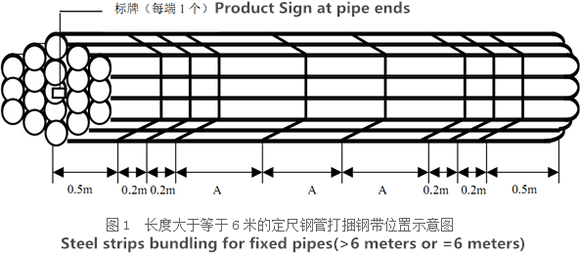
Our packing can meet any needs of the customers.
Need to inquire about our products? Fill out the form below and our staff will be in touch!
Q: How long is your delivery time? A: The delivery time of customized products is generally 25 35 days, and non customized products are generally shipped within 24 hours after payment. Q: Do you provide samples? Is it free? A: If the value of the sample is low, we will provide it for free, but the freight needs to be paid by the customer. But for some high value samples, we need to charge a fee. Q: What are your payment terms? A: T/T 30% as the deposit,The balance payment is paid in full before shipment Q: What is the packaging and transportation form? A: Non steaming wooden box and iron frame packaging. Special packaging is available according to customer needs. The transportation is mainly by sea. Q: What is your minimum order quantity? A: There is no minimum order quantity requirement. Customized products are tailor made according to the drawings provided by the customer.